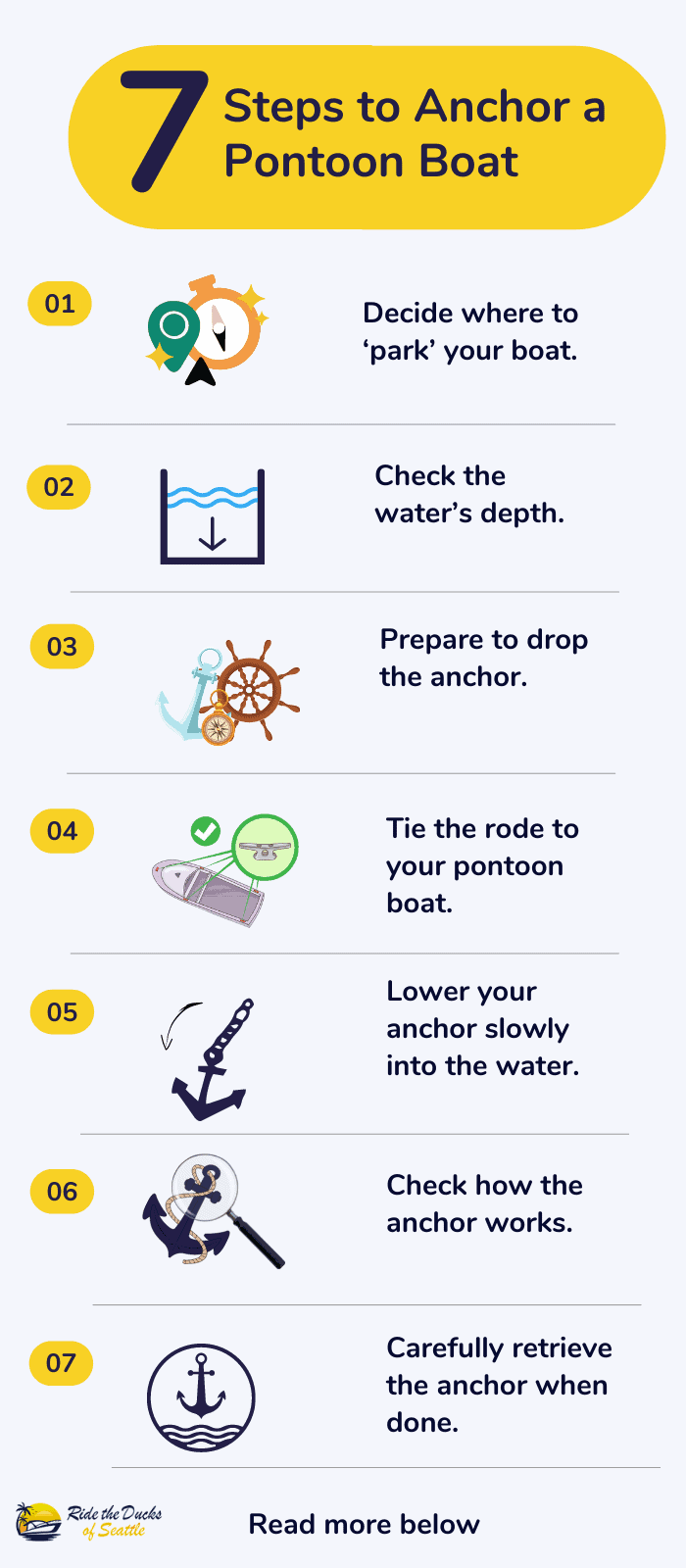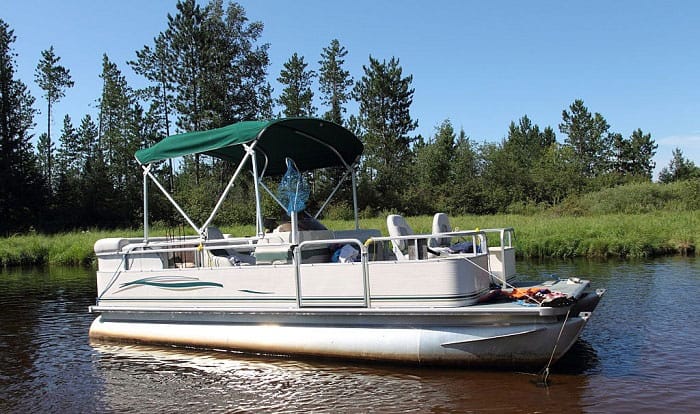Are you a first-time owner of a pontoon boat? Do you find its expansive deck perfect for hosting a small party for your friends, fishing, exchanging laughter and stories, and having a good time?
While the boat’s buoyancy is excellent, it can present issues in anchoring. That is why many beginner pontoon boat owners want to know how to anchor a pontoon boat properly.
Not to worry, I have eight straightforward steps to help you position and stabilize your pontoon boat in any body of water.
Things You Need for This Guide
You only need a few things for anchoring a pontoon boat safely and effectively.
1. Correct Boat Anchor
The best way to anchor a pontoon boat depends on the type of anchor you have. Anchors work with different bottom characteristics, such as gravel, mud, rock, and sand. Your boat’s stability on the water hinges on how well the anchor grabs the ground at the bottom of the river or lake.
A box anchor is suitable for river and lake bottoms with light vegetation or a muddy ground. It has multiple grappling surfaces, allowing it to dig into the mud effortlessly. This anchor requires a cable sufficiently long to produce a 5:1 scope.
On the other hand, fluke anchors work best with sand and gravel. Hence, they are ideal when taking your pontoon boat into the sea. Fluke anchors are available in various sizes and can be used for inflatables, not just boats.
Grapnel anchors are suitable for rocky bottoms because the arms resemble grappling extensions. Unfortunately, anchoring with them is not as straightforward as using fluke or box anchors.
2. Depth Finder
A depth finder will make it easier to calculate the correct anchor cable length. This device transmits sound wave pulses into the water, bouncing them off the bottom surface. A computer then analyzes the data to give you the water’s depth.
You can then multiply the number by five to seven to get the ideal anchor cable length.
3. Other Tools
You might want to invest in a good-quality winch to simplify the lowering and raising of the anchor. You also avoid tangling the line.
An anchor ledge is always a nice addition because it saves space in your pontoon boat, giving a platform for storing your anchor.
If you want a more secure anchor storage solution, you might need a padded, PV-coated, or mesh unit.
Finally, extra rope on your pontoon boat never hurts.
Steps for Anchoring Your Pontoon Boat
Step 1. Decide where to ‘park’ your boat.
Anchoring a boat in a lake or river is more hassle-free than securing it in the open sea. The water is calmer, allowing you to position your pontoon boat wherever you want.
However, it would be best to check your surroundings and steer clear of rock formations and river banks. I also recommend maneuvering your boat so that its nose faces the strongest wind or current.
If the water is calm and the weather is not windy, you can position your pontoon boat in any direction.
Step 2. Check the water’s depth.
A depth finder is handy for this step. Note the water depth on its display because you will need this information to determine the anchor cable or rode’s length.
The rode length should be five times the water’s depth. For example, if the depth is 20 feet, the anchor cable length should be 100 feet.
You can also check Boat US’s expert advice on calculating the correct scope for a more detailed explanation concerning determining your rode length.
Step 3. Prepare to drop the anchor.
Turn off your pontoon boat’s engine and try to stabilize your watercraft before lowering the anchor. Most boat owners put the motor on idle, allowing them to move to another location if the anchoring activity fails.
It would be best to ensure the vessel’s stillness in the water to properly anchor a pontoon boat.
Pro Tip: You can position your pontoon boat’s bow a bit forward towards where you plan to anchor.
Step 4. Tie the rode to your pontoon boat.
The next step requires you to decide where to tie anchor on pontoon boat. Check your pontoon boat for the location of its cleats or mooring clears. These fixtures allow you to secure the boat to a dock or anchor.
If you are unfamiliar with nautical knots, you might want to check out InnerBark Outdoor’s video on the seven essential knots.
On the other hand, there is no need to look for a place to tie the anchor if your pontoon boat has an underdeck anchor. I also recommend securing the anchor close to the battery of an electric winch if your boat has one.
Step 5. Lower your anchor slowly into the water.
You might have seen people throwing anchors into the water in Hollywood films. I beg you, do not do this. Tossing the anchor into the water without a care in the world can cause safety issues because of a tangled anchor cable.
Hurling the anchor overboard can also impact its positioning at the bottom. If it lies incorrectly, you cannot expect the anchor to secure your pontoon boat.
Remember to lower the anchor carefully and slowly.
Step 6. Check how the anchor works.
With the anchor in the water, let it sink to the bottom until it secures in place. You might see your pontoon boat drifting with the current or strong wind. The anchor for pontoon boat should not let you move away from your initial position too far.
Although tugging the line several times can help you determine adequate anchorage, I still recommend testing it. You can turn on your boat’s engine and put it in reverse to check if the watercraft moves.
Alternatively, you can look for landmarks on the shore as a visual reference. With your eyes fixed on a mark, you can observe if your pontoon boat is moving or not. You can also check your reference point every few hours to determine drifting from the boat’s original position.
Pro Tip: If the water current is too strong, I recommend lowering another anchor to prevent the pontoon boat from drifting. You can secure the extra anchor on the boat’s rear or side.
Step 7. Carefully retrieve the anchor when done.
Just as you want to lower the anchor to the bottom of the lake carefully, you will also need to be extra cautious when pulling it out. You will not want the anchor scraping your pontoon boat’s side.
Remember, anchors have corrosion-resistant heavy-duty metals that easily puncture an aluminum hull. Hence, it would be best to raise the anchor at a vertical angle.
Here is an informative video from Barletta Boat Company, LLC showing people how to anchor a boat.
Tip: For easy anchor retrieval, you can even attach boat anchor clips on the cable for extra functionality.
Conclusion
I hope this tutorial on how to anchor a pontoon boat increased your confidence in securing your watercraft in rivers and lakes. You can now enjoy fishing, swimming, and other water-related activities with your family and friends without drifting from your preferred site.
If you found this guide beneficial, please share it with your acquaintances. I am confident they would love to learn what you already know. You can also shoot me questions or send me any feedback about this article.

Ten years of enjoying countless trips on boats never made me love them any less! So I am here to put all those experiences into good use for other boaters who want to have a safe and fun trip with their friends and families.




